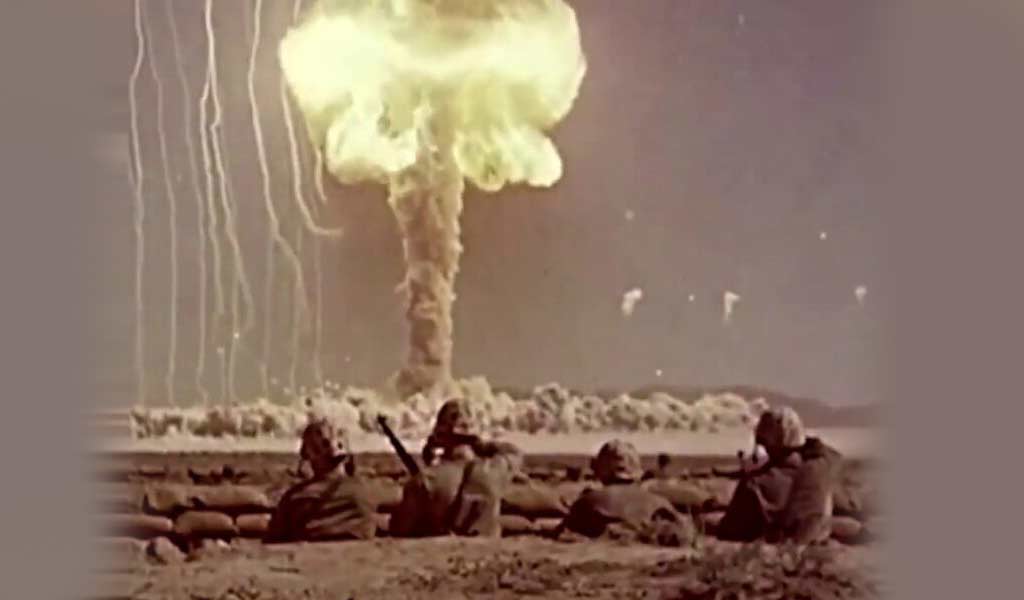Atomic Marines

by LtCol Lynn “Kim” Kimball, USMC (Ret)
Operation Crossroads’ atomic bomb tests at Bikini Atoll in July of 1946 erased any lingering doubts that might have remained following their use at Hiroshima and Nagasaki in August of 1945 about the monumental impact of these weapons in future warfare. The Marine Corps’ major contribution to Allied victory in WW II, the doctrine of waterborne amphibious assault, one of the five most significant tactical innovations of the 20th century, was immediately rendered obsolescent. A key observer at these tests, Marine LtGen Roy S. Geiger, reported succinctly to the Commandant that a complete review of the current concept of amphibious operations would have to be made given that an atomic bomb could easily destroy an expeditionary force as currently configured; some means had to be found to permit a greater initial dispersion while allowing the necessary concentration of the attacking elements in the assault. Forward looking Marine Corps planners found the solution: vertical envelopment by helicopter, the paradigm changing heliborne assault, which was to join the amphibious assault on the list of the five most significant tactical innovations of the 20th century.
As during the 1930s, the Marine Corps had to develop a doctrine employing vehicles and capabilities not yet existing or even on the drawing board, but they prevailed, and the resulting doctrinal publication, promulgated in November 1948 by again, Marine Corps Schools at Quantico, was the world’s first printed textbook detailing the tactics and techniques of helicopter employment. A parsimonious defense establishment, otherwise enthralled with the Air Force and cost cutting, inhibited more expeditious development. But with an expanding Cold War, the detonation of an atomic device by the Soviets in 1949, and the unanticipated onset of a war on the Korean Peninsula in June of 1950, particularly with the massive Communist Chinese intervention in November and the frightening possibility of Soviet involvement, the Marine Corps found itself shortly with an expanded budget and more opportunities to develop its concepts and equipment for the future. This was done under the looming pall of nuclear weapons on the battlefield. The Marine Corps felt they had a vehicle, the helicopter, and a doctrine that would permit success in such a scenario. Such a scenario was, however, unparalleled in military history and replete with unknowns shared across the Armed Forces.
To study the effects of nuclear weapons (i.e., atomic (fission) bombs or hydrogen (fusion) bombs. No fusion devices were used in the subject tests.) in a combat environment, a series of exercises conducted jointly by the U.S. military in conjunction with the Atomic Energy Commission involving the atmospheric detonation of nuclear devices in the presence of ground troops was initiated in 1951 under the broad code name of Desert Rock. The newly established and highly restricted Nevada Proving Grounds (later renamed the Nevada Test site-NTS), 65 miles northwest of Las Vegas, was the testing site until the series was discontinued in 1957. All services were represented although the Army was the major provider of troops, followed by the Marine Corps.
Marine Corps participation was structured into task-organized units designated Marine Corps Provisional Atomic Exercise Brigades (MCPAEBs, 1st – 4th); the majority of assets, particular the aviation elements, being provided by west coast bases and stations because of their obvious proximity to the NTS. Carolina Marines were there, in the 1st and 2nd MCPAEBs, forming one battalion of a two-battalion regiment with a corresponding battalion from the 1st Marine Division (MarDiv) at Camp Pendleton. The 1st MarDiv provided the single-battalion ground element of the 3rd and 4th MCPAEBs, which was then considered sufficient for the testing parameters. Numbered Desert Rock (DR) I-VII, these exercises were further divided into code-named Nuclear Test Series/Operations. Marine Corps participation was in DR IV-Operation Tumbler-Snapper (1st MCPAEB), DR V-Operation Upshot-Knothole (2nd MCPAEB), DR VI-Operation Teapot (3rd MCPAEB) and DR VII-Operation Plumbbob (4th MCPAEB). Camp Lejeune’s Marines found themselves under the atomic cloud in Tumbler-Snapper and Upshot-Knothole.
The first direct exposure of Marines to the atomic bomb came on 1 May 1952 during DR IV and shot “Dog,” the fourth in the Tumbler-Snapper series. (All atomic detonations in the NTS were called “shots”). Camp Lejeune provided the 2nd Provisional Battalion, a composite unit drawn from the 2nd MarDiv, Force Troops and other Fleet Marine Forces Atlantic units; Camp Pendleton the 1st Provisional Battalion. After arriving at Camp Desert Rock, the NTS Military Support Facility, the Lejeune Marines by a 2nd Marine Aircraft Wing (MAW) airlift, and in a sequence followed by subsequent exercises, the Marines were billeted, received orientations, conducted training and emplaced heavy military equipment and other items to be tested in vicinity of ground zero.
On the initial test date, 1 May, they were trucked to a line of four-foot-deep trenches 7000 yards south of the drop point in full battle gear. At 0830, an Air Force B-45 dropped a 19-kiloton (kt) atomic bomb that detonated 1040 feet above the huddled Marines, bathing the area in an unholy light, manifestly brighter than a multitude of suns. Their sensory perceptions over whelmed, some swore they could see the bones in their arms even with their eyes clinched. A rolling, jarring earth quake and tornadic, searing and deafening winds followed, accompanied by a blinding dust cloud. Emerging from the trenches, they advanced, conducting tactical maneuvers to within 900 yards of ground zero, where they investigated the damaged military equipment. After a two hour and 20- minute exposure, they were subjected to psychological and medical testing before being returned to Camp Desert Rock.
DR V and shot “Badger,” the sixth in the Upshot-Knothole series, provided Marines with their next exposure to a nuclear battlefield as part of the 2nd MCPAEB on 18 April 1953. Camp Lejeune’s contribution to the ground element this time was the 1st Battalion, Eighth Marines, reinforced with detachments from the 10th Marines, 2nd Engineer, Tank, Ordnance and Signal Battalions and Force Troops, which was paired with the 2nd Battalion, Third Marines and reinforcing detachments from Camp Pendleton. For this test, the troops would be entrenched 4000 yards from a 23 kt atomic device mounted on a 300-foot tower. A new feature would be added demonstrating the Corps’ innovative new tactical concept, a heliborne assault, to follow-up in the exercise scenario of an atomic attack against an enemy force during an amphibious operation.
As it had for amphibious and helicopter operations, the Marine Corps was at the forefront of tactical development and had published an Interim Doctrine for the Conduct of Tactical Atomic Warfare in February 1953 based in part on Desert Rock. At this point, it was the first and only doctrinal publication promulgated by any of the armed forces concerning atomic warfare. DR V would provide the first opportunity to test this doctrine. Marine Helicopter Transport Group (MAG (HR))-16, a west-coast asset, would provide thirty-nine helicopters (H-19) from HMR-361, -162 and -163 to constitute the aviation element. The Marine Corps was uniquely qualified to test these doctrines. In 1953, the Marines could rightfully claim to having more experience in helicopter operations and possessing more helicopters, trained pilots and crewmen than any other military organization in the world.
Badger detonated at 0435, becoming an incandescent red, white and orange fireball that enveloped the trench hugging Marines in the same thermal radiation pulse, kinetic shock wave, and ionizing radiation that characterized Dog and all subsequent shots. Helicopters poised for takeoff seven miles from the trenches, their dark blue coloration appearing ghostly white from the flash. The 1st Battalion was able to advance only 500 yards from the trenches and incinerated brush before it was turned back by dangerously radioactive fallout. Advancing from different positions, the 2nd Battalion maneuvered under the atomic cloud, churning tens of thousands of feet into the atmosphere, to the objective area 2000 yards from ground zero, their attack coinciding with that of a heliborne company lifted by H-19s, the first employment of helicopters in a nuclear warfare scenario. After inspecting the equipment and other exhibits subjected to the explosion, the Marines were tested, as before, and returned to Camp Desert Rock.
This exercise concluded Camp Lejeune’s participation in Desert Rock and the baptism of approximately 1250 of its troops as “Atomic Marines” but not the Marine Corps’ participation. West coast Marines provided ground and aviation elements to constitute the 3rd MCRAEB for DR VI (Operation Teapot) and shot “Bee,” an 8 kt device mounted on a 500-foot tower detonated on 22 March 1955. Also constituting the 4th MCPAEB for DR VII (Operation Plumbbob) and shot “Hood,” a 74 kt, balloon-tethered device elevated to 1500 feet and detonated on 5 July 1957. Hood was the largest atmospheric test conducted at the NTS. In addition to continuing to exercise and test the viability of employing helicopters in a nuclear environment, these latter exercises also first tested another Marine Corps innovation on an atomic battlefield, Close Air Support, this provided by Marine Attack Squadrons from the 3rd MAW.
Also present at DR VI and shot “Bee” was a uniquely task-organized and heavily augmented infantry battalion designated Marine Corps Test Unit No. 1 (MCTU #1). Activated at Camp Pendleton on 1 July 1954 by order of the Marine Commandant, its assigned mission was to study the problems associated with the restructuring and employment of a Marine division for heliborne operations in a nuclear warfare environment, based on the Corps’ newly developed, paradigm-changing doctrines. It operated concurrently with the 3rd MCPAEB also utilizing the available Corps’ aviation assets, and was deactivated on 19 June 1957 having completed a litany of directed projects attempting to address the unknowns associated with nuclear warfare. Concluding, somewhat optimistically before the long-term effects of ionizing radiation from fallout were fully appreciated, that operations within close proximity to a nuclear explosion were feasible.
REFERENCES
“A-Bomb Kaleidoscope of Chaos.” Globe, 23Apr53.
“A-Bomb Witnesses take Maneuver in Stride.” Globe, 8May52.
Daniel Chandler, Cpl, USMC. “Marines Under the Bomb,” Leatherneck, Sep16.
- Avery Chenoweth. “The Marine Corps Atomic Bomb Tests.” Marine Corps Gazette, Apr02.
Kenneth J. Clifford, LtCol, USMC. Progress and Purpose: A Developmental History of the USMC, 1900-1970. HQMC, History and Museums Division, 1973.
Dean DeWolfe, LtCol, USMC (Ret). “Atomic Testing.” Letter- Marine Corps Gazette, Jul02.
Gerald W. Fischer, Col, USMCR (Ret). “Marines Who Were Under the Bomb are Entitled to Compensation.” Leatherneck, Nov16.
Allan R. Millet. Semper Fidelis: The History of the USMC. Macmillan Publishing Company, 1980.
Operations Tumbler-Snapper, Upshot-Knothole, Teapot and Plumbbob. Fact Sheets, Defence Threat Reduction Agency, Various dates.
Roy E. Heinecke. “Desert Rock V.” Leatherneck, Jul53.
“Leatherneck Nucleus Tests New Atom War Concept.” Globe, 23May53.
“Lejeune Elements Nucleus of Marine A-Bomb Observers.” Globe, 17Apr52
Pete Nealen. “Marine Corps Test Unit 1.” SOFREP Media Group. https://sofrep.com/news, downloaded 3Nov21.
Eugene W. Rawlins, LtCol, USMC. Marines and Helicopters 1946-1962. HQMC, History and Museums Division, 1976.
Eugene E. Shoults, Col, USMC (Ret). “Atomic Testing.” Letter-Marine Corps Gazette, Jul02.
Robert A. Suhosky, “Biggest shot.” Letter-Leatherneck, Sep57.
Posted on: April 25, 2022

